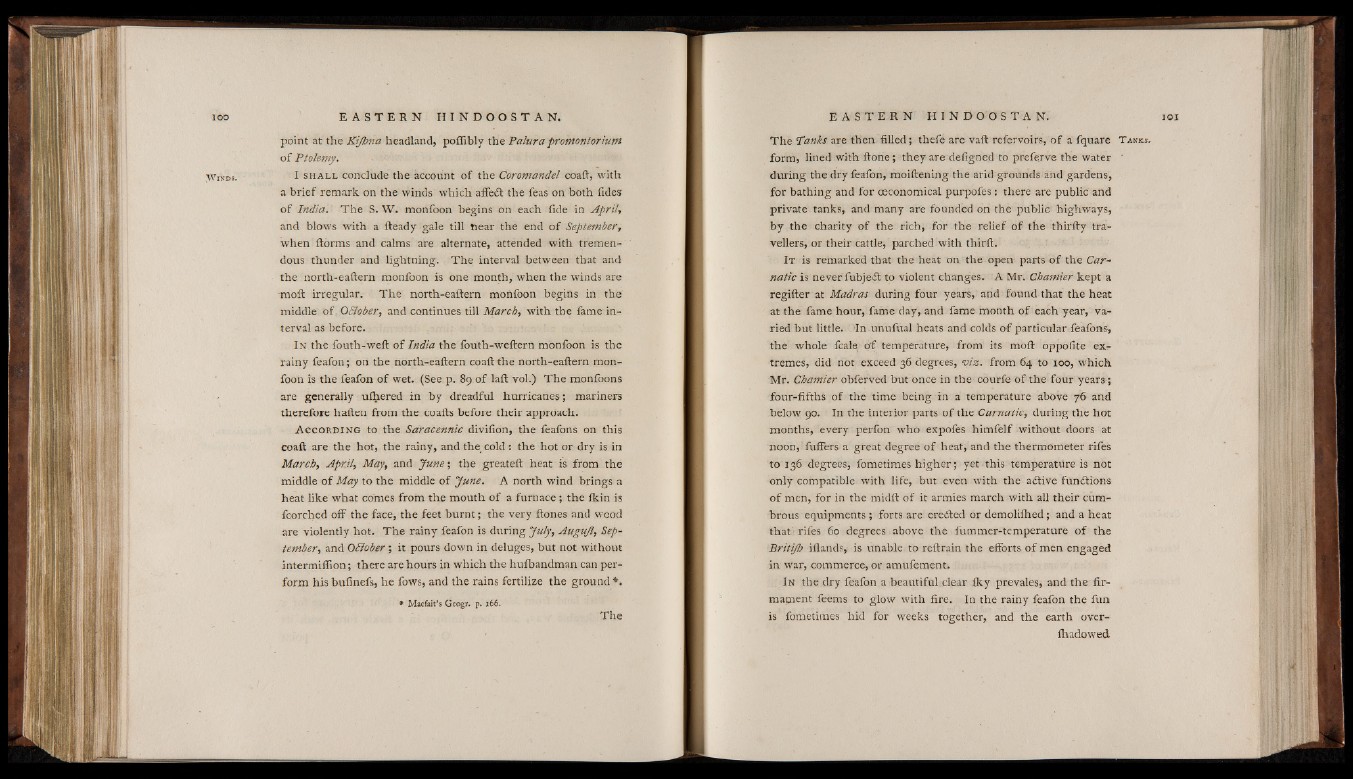
W in d s .
point at the Ki/hna headland, poftibly the Palura promontorium
of Ptolemy.
I s h a l l conclude the account of the Coromandel coaft, with
a brief remark on the winds which affetft the feas on both iides
of India. The S. W. monfoon begins on each fide in April,
and blows with a fteady gale till Hear the end o f September,
when ftorms and calms are alternate, attended with tremendous
thunder and lightning. The interval between that and
the north-eaftern monfoon is one month, when the winds are
moft irregular. The north-eaftern monfoon begins in the
middle of October, and continues till March, with the fame interval
as before.
I n the fouth-weft of India the fouth-weftern monfoon is the
rainy feafon; on the north-eaftern coaft the north-eaftern monfoon
is the feafon of wet. (See p. 89 of laft vol.) The monfoons
are generally uihered in by dreadful hurricanes; mariners
therefore haften from the coafts before their approach.
A c c o r d i n g to the Saracennic divifion, the feafons on this
coaft are the hot, the rainy, and the cold: the hot or dry is in
March, Apr.il, May, and June; the greateft heat is from the
middle o f May to the middle of June. A north wind brings a
heat like what comes from the mouth of a furnace; the ikin is
fcorched off the face, the feet burnt; the very ftones and wood
are violently hot. The rainy feafon is during July, Augufl, September,
and October; it pours down in deluges, but not without
intermiflion; there are hours in which the huibandman can perform
his bufinefs, he fows, and the rains fertilize the ground *.
* Macfait’s Geogr. p. 166.
The TanhS are then filled; thefe are vaft refervoirs, of a fquare Tanks.
form, lined with ftone; they are defigned to preferve the water ‘
during the dry feafon, moiftening the arid grounds and gardens,
for bathing and for ceconomical purpofes: there are public and
private tanks, and many are founded on the public highways,
by the charity of the rich, for the relief of the thiffty travellers,
or their cattle, parched with thirft.
I t is remarked that the heat on the open parts o f the Carnatic
is never fubjeft to violent changes. A Mr. Chatnier kept a
regifter at Madras during four years, and found that the heat
at the fame hour, fame day, and fame month of each year, varied
but little. 'In unufual heats and colds of particular feafons,
the whole fcala o f temperature, from its moft oppofite extremes,
did not exceed 36 degrees, viz. from 64 to 100, which
Mr. Chamier obferved but once in the courfe of the four years;
four-fifths of the time being in a temperature above 76 and
below 90. In the interior parts of the Carnatic, during the hot
months, every perfon who expofes himfelf without doors at
noon, fuffers a great degree of heat, and the thermometer rifes
10136 degrees, fometimes higher; yet this temperature is not
only compatible with life, but even with the aiftive functions
of men, for in the midft of it armies march with all their cumbrous
equipments ; forts are eredied or demoliihed; and a heat
that ■ rifes 60 degrees above the fummer-temperature of the
Britijh iilands, is unable to reftrain the efforts o f men engaged
in war, commerce, or amufement.
I n the dry feafon a beautiful clear iky prevales, and the firmament
feems to glow with fire. In the rainy feafon the fun
is fometimes hid for weeks together, and the earth overihadowedi
101